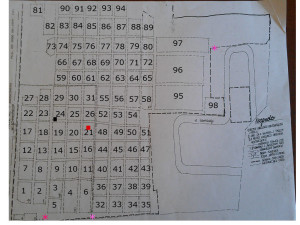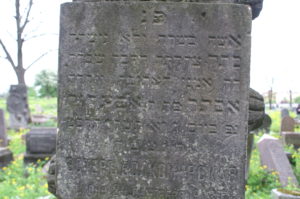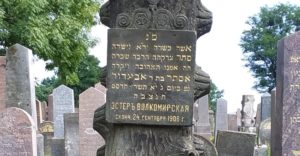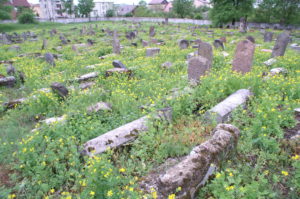The images featured in the galleries below offer before and after views of Bagnowka Jewish Cemetery in Bialystok, Poland, as the cemetery undergoes restoration. Images are both of sectional views and of individual tombstones. Before photos date to c. 2006-2007; after images from 2014-2018, unless otherwise noted. Additional photos will be added here, organized by sections, as they become available. Often the most dramatic realization of the impact of restoration is seen in the background of individually restored tombstones.
Section 7
Ester b. Avigdor Wolkomirskaya (d. 1908): 2007, 2017
Section 7, located within the main entrance, is one section north of Section 1. Extant burials of men and women span the years c. 1896-1922. Epitaphs preserved, are written in Hebrew, Yiddish, Russian, German and Polish. In 2013, three matzevoth were restored in this section, reflecting the diverse careers of Bialystok’s residents. These matzevoth belong to: the merchant Nathan Falkner (d. 1896): Julian Heublum, a lieutenant in the Polish army and a medical student (d. 1920); and Dr. Flatte (d. 1921). In 2017, restoration of this section was completed. Two most unique discoveries were the bilingual tombstone of Dr. Sophia (Sheina Lea) Garfunkel Kuricki (d. 1919), the only inscription thus far that recalls a woman in a professional role; and the small tombstone of a young man, Eliyahu Helerstein (d. 1919), with its uniquely painted inscription. The latter was restored by the local conservator’s office. Two pages of before and after images can be seen in the gallery below.
Section 8
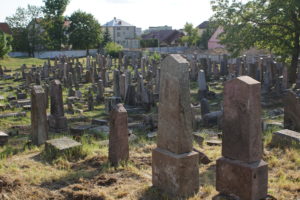
Section 8 is located within Bagnowka’s main entrance, just north of Section 2, at left on entering. Burials of men and women, who died c. 1900-1917, are recorded in epitaphs, written predominately in Hebrew with an occasional word in Yiddish and select German and Russian epitaphs. Many of the matzevoth in this section are crafted of variegated stone, with surface worn, making translation extremely challenging. Examples of fine folk art symbols and Hebrew poetry are preserved in this section. This section has had some restoration in 2017 with more planned for 2019.
Photographic credit: Frank J. Idzikowski, Dr. Heidi M. Szpek and Dr. Tomasz Wisniewski.
